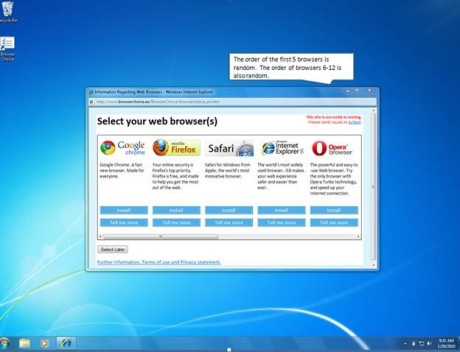
Microsoft's web browser choice screen
The browser choice screen was preferred over Microsoft's earlier decision to ship boxed copies of Windows 7 without a browser at all.
In a bog post, Dave Heiner, Microsoft's Deputy General Counsel, said: "Internal testing of the choice screen is underway now. We'll begin a limited roll-out externally next week, and expect that a full scale roll-out will begin around March 1, a couple of weeks ahead of schedule."
Under the scheme, Microsoft's automated Windows Update service will present users with a screen showing a range of browsers, with the top five presented in random order. Users will be able to click a button to install whichever browser they like, or ask for more information from the browser's provider.
The selection may change if there are changes in market share.
The EU case was kicked off by complaints from Opera, which is based in Norway. Opera has been markedly less successful than Firefox at getting users to adopt its desktop browser. According to usage-based statistics from Statcounter, Microsoft's IE has a 45.4% market share in Europe, followed by Mozilla Firefox (39.3%), Google Chrome (6.4%), Opera (4.3%), and Apple's Safari (3.7%).
It's not clear how much difference the browser choice screen will make. A large proportion of Microsoft's browser users -- especially in large companies and government organisations -- are still on IE6, the out-of-date version that shipped with Windows XP in 2001. They have already declined to upgrade to IE7 and the current version, IE8, which is far more secure and also more in line with Internet standards.
Many large organisations have applications that may use IE6 features not provided in other browsers, and they would have to test them to make sure they continue to work even if they upgraded to IE7 or IE8. The cost of testing and perhaps rewriting apps means they are not prime candidates for a non-Microsoft browser.
If IE6 users are removed from Statcounter's statistics, then Firefox is already level with Internet Explorer (within 0.1%) in Europe, and the figures show that IE is in long-term decline. In fact, ordinary Windows users have always been able to download alternative browsers, and they have demonstrably been adopting Firefox for the past several years, with no help from the EU.
Although Opera may gain market share from being included in Microsoft's "browser ballot", it is still not competing on a completely level playing field. For example, Apple does not offer Opera to Mac users (it bundles Safari with its proprietary Mac OS X), and Google -- which has a monopoly market share in web search -- does not promote Opera alongside its own Chrome browse

No comments:
Post a Comment